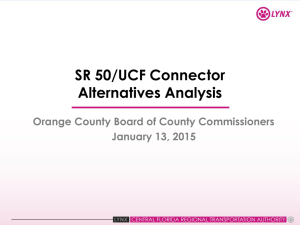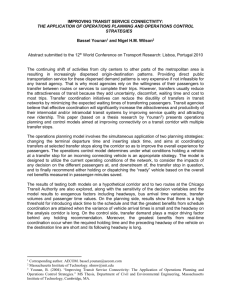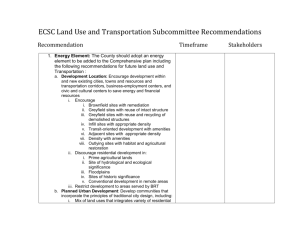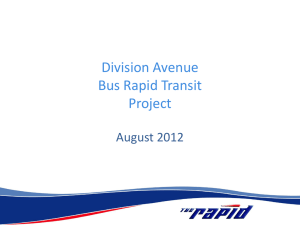BRT Feasibility Study Project Scope
advertisement
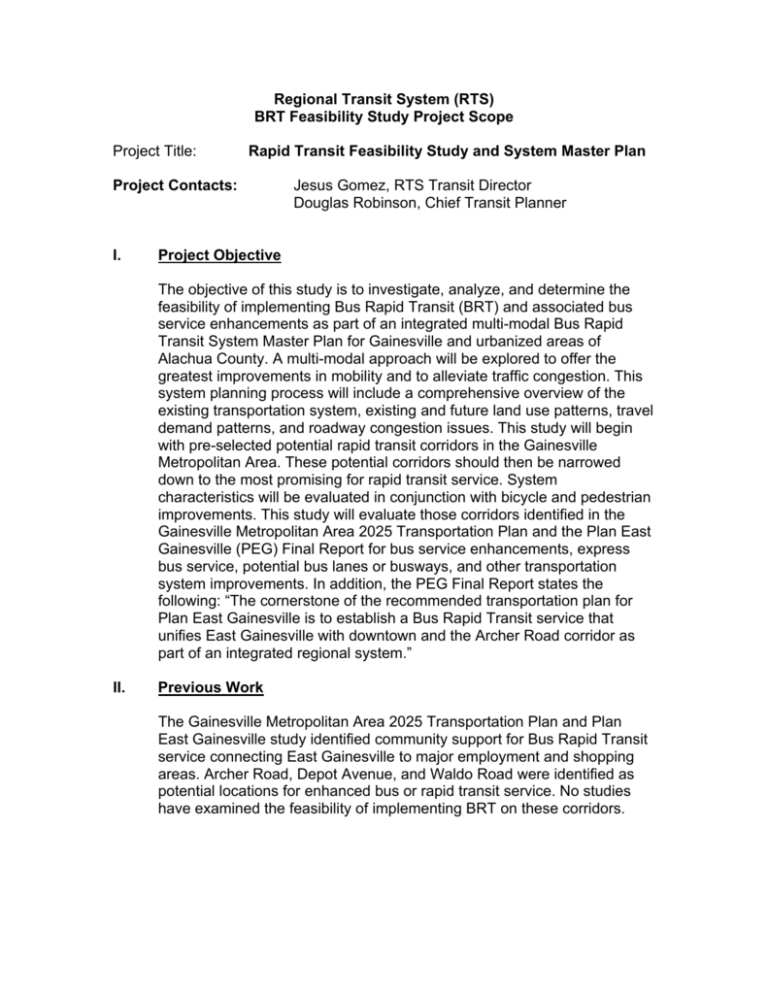
Regional Transit System (RTS) BRT Feasibility Study Project Scope Project Title: Rapid Transit Feasibility Study and System Master Plan Project Contacts: I. Jesus Gomez, RTS Transit Director Douglas Robinson, Chief Transit Planner Project Objective The objective of this study is to investigate, analyze, and determine the feasibility of implementing Bus Rapid Transit (BRT) and associated bus service enhancements as part of an integrated multi-modal Bus Rapid Transit System Master Plan for Gainesville and urbanized areas of Alachua County. A multi-modal approach will be explored to offer the greatest improvements in mobility and to alleviate traffic congestion. This system planning process will include a comprehensive overview of the existing transportation system, existing and future land use patterns, travel demand patterns, and roadway congestion issues. This study will begin with pre-selected potential rapid transit corridors in the Gainesville Metropolitan Area. These potential corridors should then be narrowed down to the most promising for rapid transit service. System characteristics will be evaluated in conjunction with bicycle and pedestrian improvements. This study will evaluate those corridors identified in the Gainesville Metropolitan Area 2025 Transportation Plan and the Plan East Gainesville (PEG) Final Report for bus service enhancements, express bus service, potential bus lanes or busways, and other transportation system improvements. In addition, the PEG Final Report states the following: “The cornerstone of the recommended transportation plan for Plan East Gainesville is to establish a Bus Rapid Transit service that unifies East Gainesville with downtown and the Archer Road corridor as part of an integrated regional system.” II. Previous Work The Gainesville Metropolitan Area 2025 Transportation Plan and Plan East Gainesville study identified community support for Bus Rapid Transit service connecting East Gainesville to major employment and shopping areas. Archer Road, Depot Avenue, and Waldo Road were identified as potential locations for enhanced bus or rapid transit service. No studies have examined the feasibility of implementing BRT on these corridors. III. Methodology Hire CUTR-led consultant team. IV. Work Plan The work plan for BRT study is organized into 11 major tasks, as listed below and summarized in the remainder of this scope of services. Task 1: Task 2: Project Management & Coordination Develop a Public Involvement Plan (PIP) and conduct public workshops Task 3: Collect Data and coordinate with local transportation organizations Task 4: Identify Potential Corridors for Rapid Transit Consideration Task 5: Develop Criteria Screening Process for Corridor Evaluation Task 6: Conduct Technology Assessment Task 7: Conduct Corridor Selection and Refinement Task 8: Prioritize Alternative Service/Configurations Task 9: Select Final Priority Corridors and Prepare Implementation Plans Task 10: Develop BRT Project Schedule and Milestones Task 11: Prepare Draft – Final Report Task Descriptions Task 1: Project Management & Coordination This task will involve the development of a study management structure that will include a nucleus project management team (PMT) consisting of RTS project management, MTPO staff, FDOT District 2 staff, UF representatives and CUTR / Tindale-Oliver & Associates (TOA) staffs. The existing MTPO technical and citizen committees will be utilized as advisory review committees of draft products produced at key milestones of the study. A PMT meeting schedule and milestone presentation schedules for the review committees will be produced within 30 days of Notice-To-Proceed (NTP). Deliverable: Project Management & Presentation Schedule Task 2: Develop a Public Involvement Plan and Conduct Public Workshops This task will result in the development and implementation of a Public Involvement Plan that is consistent with the Metropolitan Transportation Planning Organization’s (MTPO) adopted public involvement process, and clearly represents all citizens, including ethnic, minority, and low-income groups; people with disabilities; elderly citizens; and other groups traditionally under-represented in the transportation planning process. Outreach efforts of this Public Involvement Plan shall take place at all critical steps in the study process. It is anticipated that MTPO staff will actively participate in the implementation of the Public Involvement Plan, including assistance with the scheduling of appropriate locations and dates, the advertisement and marketing of the workshops and any other involvement activities, and the recruitment of desired participants. Deliverable: • • • • • Task 3: Public Involvement Plan including: Identify appropriate public involvement activities for the effort Develop a schedule for all public meetings, workshops, presentations, and/or any other identified activities Develop a project schedule by task with milestones Conduct public meetings to identify community attitudes Use consensus building tools for presentations Select participants (agencies, elected officials, general public) Collect Data and Coordinate with local transportation organizations The MTPO and RTS will assist the consultant team in obtaining all primary and secondary data necessary to complete the project objective. At a minimum, the data necessary for this analysis will include: • • • • • • • • • Traffic counts Intersection turning movement counts and/or intersection LOS information Travel demand flows (e.g., travel demand model output) Roadway characteristics (lanes, right-of-way [ROW] widths, speed, turning movements, etc). Bus ridership at the route and stop level Residential and employment density data (in relation to corridors) Future growth patterns Traffic signal interface (controllers, software, hardware, timing) GIS shapefiles/aerials • • • • • • • Property Appraiser data on parcel ROW boundaries Land use studies Current proposed plans for roadway improvements/reconfigurations Community attitudes and community resources UF Campus Master Plan (including Data & Analysis reports) Park and Rider corridor analysis Other information as deemed necessary during analysis phase The MTPO and RTS will assist the consultant team in collecting previously prepared materials from the list above. Task 4: Identify Potential Corridors for Rapid Transit Consideration In addition to analyzing the data from Task 3, the consultant team will examine approved transportation and land-use plans. Site visits to identified corridors will be conducted in order to verify secondary data and to visually inspect each corridor identified below to assess the potential application of Bus Rapid Transit (BRT) transit technologies and specific elements thereof (e.g., the use of exclusive running ways versus mixedtraffic operation). Digital photography will be used to catalog and illustrate the characteristics of the potential corridors. The MTPO and RTS will assist the consultant team in identifying all relevant land use and transportation plans. The MTPO and RTS will also provide the consultant team with a final pre-selected list of potential corridors to review. Pre-Selected Corridor List The corridor list below will be analyzed and prioritized for rapid transit (BRT) application: 1) 2) 3) 4) 5) 6) 7) 8) SW 20th Avenue/SW 62nd Boulevard University Avenue/Newberry Road 13th Street SW 23rd Terrace and SW 35th Place Archer Road (from Tower Road to SW 13th Street) Depot Avenue (from SW 13th Street to Waldo Road) Waldo Road (from Depot Avenue corridor to Airport industrial Park) Hawthorne Road/State Road 20 (from Waldo Road to SE 43rd Street) Task 5: Develop Criteria Screening Process for Corridor Evaluation A criteria screening process will be developed in order to evaluate and screen the eight identified potential corridors and establish an objective process with which to select the most promising corridors for Bus Rapid Transit service enhancements. In developing the criteria screening process, consideration shall be given to such elements as financial and environmental feasibility. In addition, consideration will be given to any proposed FDOT/MTPO pedestrian and bicycle plans or improvements. The criteria screening process will make use of the compilation and review of data from existing sources indicated in Task 3. Using the data, corridor profiles will be developed for the corridors identified in Task 4. It is envisioned that the screening process developed for the evaluation of the selected corridors will consider: • • • • • • • • • existing and future transit demand existing transit services and infrastructure future transit market potential existing and future corridor residential and employment densities existing and future roadway and intersection geometries existing and future traffic conditions and travel flows compatibility with regional and local plans environmental/ROW constraints environmental justice The evaluation of zonal travel demand flows will be important to the overall analysis; however, this task will not include any specific modeling work. Instead, the screening process will utilize existing available Gainesville area travel model data on existing and future travel patterns, as well as existing ridership data in the corridors or parallel corridors. This task, then, will help assess and verify the feasibility of each corridor for potential rapid transit applications, as well as provide information that can be used in the subsequent comparative prioritization of the feasible corridors for implementation. Task 6: Conduct Technology Assessment The purpose of the technology assessment is to: 1) discuss the characteristics and applications of BRT and the relationship to other transit modes; 2) develop a methodology for determining their applicability in Gainesville; and 3) use that methodology for determining which would be most appropriate for continued study. The potential BRT system characteristics to be explored are as follows: • • • • • • • • Running ways Stations (spacing and platform sizing) Vehicles Fare collection strategy and equipment Intelligent Transportation Systems Impacts of traffic signal changes on cross street (including freeway on/off ramps) traffic movements/speeds Coordination/connection with existing local bus service Bicycle and pedestrian connections As part of the Task 3 field work on the corridors and the completion of the criteria screening process in Task 4, a preliminary assessment of feasible corridor-specific BRT system elements will be completed. This assessment will help facilitate this task’s identification of appropriate BRT system characteristics for application in Gainesville. It is envisioned that certain rapid transit characteristics will be more applicable in some corridors than others. In that event, these issues will be reflected in the feasibility and cost benefit of implementing a rapid transit system. Task 7: Conduct Corridor Selection and Refinement The corridor selection and refinement process will continue examining the feasibility of implementing rapid transit service enhancements on the most promising corridors. This task will include the consideration of corridors functioning as systems, and corridors with the greatest potential for increasing transit ridership and alleviating traffic congestion. The selection and refinement process will require public involvement activities, such as public meetings, to present and discuss the selection process and the potential benefits associated with each identified corridor. Task 8: Prioritize Alternative Service/Configurations • • Prioritization of alternatives based on established criteria o Determine selection criteria for BRT alternative Identification of potential funding sources for implementation of BRT alternatives o Develop progressive funding strategy tied to selection of BRT alternative o Possible funding sources: Surface Transportation Program (STP) Section 5309 New Starts Funding Task 9: Urbanized Area Formula Capital Investments Grants National Highway System Intercity Bus Service Access to Jobs Transportation Infrastructure Finance and Innovation Act Clean Fuels Formula FTA Livable Communities Initiative Community Development Block Grant (CDBG) Federal earmark for high priority projects Ad Valorem from General Fund Local gas and/or sales tax State Block Grants State Transit Corridor Program Service Development Grants Commuter Assistance Program Other TBD Select Final Priority Corridors and Prepare Implementation Plans Based on the results of Tasks 5 through 8, one priority corridor will be selected for rapid transit application (secondary corridors will be described for future study opportunities). For this priority corridor, initial implementation plans will be prepared that will be consistent with the latest federal, state, and local rules and guidance. While the level of detail in these initial plans may not be sufficient to meet the requirements of the Small Starts program (though it might for a Very Small Start), they will describe and facilitate any eventual requirements under Alternatives Analysis or for NEPA Scoping. To this end, the implementation plans would include the following considerations with major project milestones: • • • • Funding and financing options from available sources (as discussed in Task 8) Incremental project development to include packaging and phasing of BRT elements Institutional arrangements BRT supportive policies (e.g. parking, land use, etc.) It is important to note that the implementation plans are intended to be preliminary in nature but will provide sufficient guidance to move forward with additional planning activities and implementation for each of the two priority corridors, as appropriate. Task 10: Develop Overall Project Schedule and Milestones • • • Task 11: Draft – Final Report • • • Task 12: V. Produce a project timeline by task Include Public meetings schedules Include Project Management Team Meetings and Advisory Committee Presentations Prepare draft report and submit for review Address draft report comments Produce final report Application Support and Project Development (Optional) - TBD Additional Project Staff Due to the multi-modal nature of this project, the consultant team shall have expertise in bicycle and pedestrian planning and traffic engineering, including traffic operations, signalization, and Intelligent Traffic Systems. VI. Schedule A detailed project budget will be developed and submitted to RTS within 2 weeks from Notice to Proceed (NTP). It is anticipated that the overall BRT study will be conducted within a nine-month time period. VII. Budget The Overall Budget for this study will be $195,499 for Tasks 1-11. (Optional Task 12 will be further refined for the final priority corridor and dependent on additional grant funding) Budget Breakdown to be provided: Labor: Sub-Consultant: Direct Expenses: Indirect Expense:
